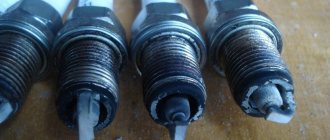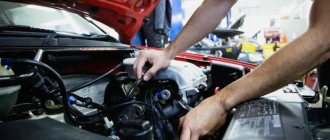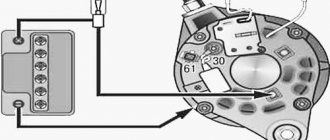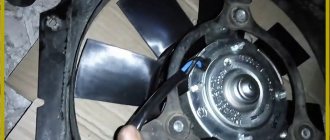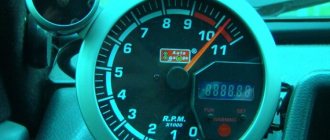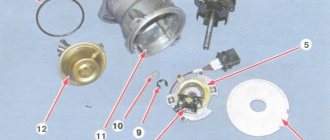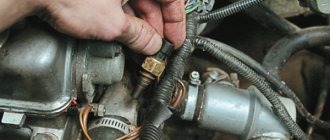Hi all! 2109 injector! The tachometer needle is jumping like crazy! The engine itself runs exactly 880-900 rpm! Where to look? Thanks in advance!. VAZ 2109 injector jumps tachometer needle.
Similar articles
32 comments on “Vaz 2109 injector jumps tachometer needle. The tachometer needle jumps like crazy.”
Nikolay, he says, the engine runs smoothly. There's something wrong with the device.
oh, sorry, take off the tidy,
It seemed to me or the arrow jumps in time with the bass.
Moz Generator Fucks
idle sensor, right?
Check the stamps on the Akuma
Andrey, that's exactly what you noticed!)) And it all started with the installation of an amplifier with a subwoofer!)) Thank you! I'll see how it will be to introduce myself as a shooter without music!)
generator. change brushes or anchor. it was such crap
Dmitry, Yes, everything new for me already costs zero reaction! As the speed increases, the voltage drops! I’ll take a new one!) At 100 amps, what do you think the norm will be, or is it still 80 amps? They have almost the same price))
somewhere there is a mass of weakness.
I think 100 will be a lot for an injector. Fuck it though, ask the sales person who you will buy from. he knows that anyway.
I had this... I don’t remember which wires, but I remember for sure that a couple were not connected, under the hood... I connected it and everything was smooth... check that all the wiring had good contact
DEFINITELY not a generator
Alexander, As the speed increases, the voltage drops!
Dmitry, are all power consumers turned off??
Alexander, I copied the text. you ask the one who asked the question
check the voltage regulator first. once it falls
Alexander, I changed everything to something new! Zero reaction! I will completely change the generator!) Music played while recording the video! I think it's because of the generator! Where exactly can these wires come from?! Everything seems to be in its place! Doesn't the tachometer itself go to the brains of the car by any chance?
Rail, I don’t remember the wires now, back then I didn’t understand the car at all. I just found two disconnected wires and connected them to the nearest empty connectors... it doesn’t make sense to change everything... trace the wiring from the tachometer starting from the instrument panel.. and further.. this 100% wired. the fact that the music was playing certainly played a role, because... consumption is high... even more so with subwoofer... you'll try without music only at idle... is that all??
Alexander, Tomorrow I’ll try to watch it without music!))
Rail, come on) good luck) the voltage at medium speed (2000 rpm) should be in the range of 13.6-14.6 volts... with the low beams on and the heater in the first position. measure it and you will understand whether the generator is working or not.
Rail, the scheme will be something like this
Alexander, Measured at XX 13.6! As the speed increases, the voltage becomes less and less!
This means that the diode in the rectifier block on the generator is broken
Alexander, And he changed it! nothing has changed! I will completely change the gene! Of course, I have one more voltage regulator (new), so I think I’ll try to change it again, if nothing changes, I’ll throw it the fuck out!)))))))))))
))) unsubscribe later))) good luck!
a lot of tidy seems... I also have a 14k, though with a temperature arrow... from the bass... from the stove when switching modes)) when you plug in the heating, the arrow rises by mm 2, the bass hammers, the arrow jumps..
Look at the mass... You can always change the gene... What if it’s not him? There are diodes on the gene, check them first... A voltage drop when the speed increases can be caused by severe wear of the brushes or weak springs... start with a simple one... stretch the springs slightly and check the condition of the brushes and clean the commutator from graphite. For example, with alcohol, gasoline can corrode the varnish on windings Then even take measurements.
I had the same thing, only on the carburetor, I hit the panel with my fist and everything started showing normally
#1 Dimsan
- Advanced Members
- 175 messages
- Car make: Kalina 1.4
- From: Mytishchi
600-800 rpm while the car runs smoothly, no increase in rpm is heard. then it stops. then the hob and down starts to twitch a little, and it’s not a loud “bang” from the pipe, not a clap, but a bassy sound. I suspect, of course, that the problems may not be related.. but nevertheless, I would like to figure it out.. this situation sometimes appears.. sometimes it doesn’t.. it might work smoothly for a minute and then again. I'm already tormented... what was done: spark plugs, high voltage wires, cleaning contacts in the distributor, a new slider, a new ignition coil, cleaning and adjusting the carb, cleaning all or almost all the mass under the hood and on the switch too. The car of course drove much better, but this did not solve the problem. I don’t know where to look anymore.
How to find the causes of failure
If you encounter a problem such as the VAZ 2109 jerking while driving, then the reason may be hidden in a malfunction such as:
- Power system problem.
- Ignition system problem.
Also, one of the main reasons that the VAZ 2109 jerks when driving is the carburetor, which urgently needs to be checked.
To determine if a car is broken, you must first prepare two wrenches (one eight, the other ten), two screwdrivers (one Phillips, the other straight), as well as a clean rag and thin copper wire. You will also need a compressor and liquid.
Malfunctions of the injection version
If you have an injection VAZ 2109, the signal to the tachometer comes from the crankshaft position sensor (CPS) through the engine electronic control unit (ECU). The inductive DPKV is located at a distance of 0.8–1.2 millimeters from the gear ring of the generator pulley, and the pulley is mounted on the crankshaft. This pulley has 58 teeth, with two pairs located at twice the distance from each other. It looks like there were 60 teeth at first, but then two were removed. Twice per revolution, when a missing tooth passes the sensor, the DPKV generates a modified signal. Based on the interval between such signals, the ECU calculates the crankshaft rotation speed and uses it both to determine the timing and duration of the injection pulse into the combustion chambers, and to send a signal to the tachometer. Failure of the ECU and DPKV, as a rule, leads to the inability to start the engine.
Your actions
- Remove the cover from the air filter.
- Remove the filter.
- Remove the drive vacuum corrector hose.
- Replacing the corrector (possible).
- Check the carburetor.
- Remove the hose that leads to the fuel.
- Pull the distributor out of the socket.
- Clean the nozzle hole.
- Put the sprayer back.
- Assemble the carburetor.
- Check the retraction of the drive lever.
- Check the trickles.
Next, most likely you will have to go to a service center or read how to properly adjust the carburetor here.
Why can the VAZ 2109 carburetor twitch?
The VAZ 2109 jerks while driving for the reason that a breakdown in this VAZ may be due to the carburetor.
Reasons why the carburetor twitches:
- Fuel filter failure. This is considered the most common breakdown in the VAZ 2109. Therefore, if jerking occurs in the car, the first thing you need to do is check this particular fault.
- Another important cause could be a breakdown of the accelerator pump.
- Broken ignition distributor. The vacuum corrector in it may break. Also, in addition to this, there may be other reasons for the breakdown. To accurately determine what happened, you need to take the car to a service center for a full diagnosis.
VAZ tachometer does not work - common reasons
- The first step is to check the condition of the wiring and contacts. Often, tachometer malfunctions lie precisely in a broken wire or poor contact. Carry out a visual inspection for defects (tears, poor fastening, oxidation, etc.).
- Malfunction of the crankshaft speed sensor. There are situations when the tachometer does not work due to a malfunction of the engine speed sensor. Checking the sensor or replacing it will help solve this problem.
- It may not be strange, but in some cases the reason for a non-working tachometer may lie in the banal wedging of the arrow or its rotation on the pulley.
- Installing contactless ignition often results in the tachometer not working. To resolve the problem, I advise you to contact an electrician who will solve the problem of the conflicting device.
- Incompatible ignition wires. The so-called silicone ignition wires, which car owners use to replace standard wires, often cause the tachometer needle to twitch. The reason lies in differences in the linear resistance of both wires; as a result, the shape of the current pulse changes and the needle behaves incorrectly. The solution to this problem is described in many manuals for self-repair, and it boils down to replacing (reducing the value) of the resistor on the control panel board.
- Check fuses. Sometimes they are the cause of problems with the tachometer. Make sure that all fuses are intact and have no signs of oxidation or melting.
What to do if the VAZ 2109 carburetor jerks during acceleration
It often happens that the VAZ 2109 carburetor twitches when accelerating the car. In this case, determining the cause of the breakdown will not be very easy. This is because there can be a lot of such reasons and which of them led to the breakdown of your car is not easy to find out.
What could be the reasons for the breakdown:
- The gasoline pump is not working well.
- Problems with the fuel filter.
- The optional filter may become clogged.
- Ignition problems may occur.
- There may also be a low level of fuel fluid in the tank.
Of course, this is not the entire list of reasons why a VAZ 2109 car may break down. In this regard, it will be quite difficult and almost impossible to independently identify the cause of the breakdown. In this regard, it is better to use the services of a service staffed by professionals. They will help to detect and quickly eliminate the cause of the breakdown and the breakdown itself.
Also, one of the reasons for the breakdown of the thing that jerks when the VAZ 2109 is moving may be that the carburetor is defective. Even a person without special skills can eliminate this reason. It's quite easy to fix.
Malfunctions on Nexia
Problems with the speedometer.
Has the speedometer stopped working on the Daewoo Nexia? The first thing you need to do is check the engine index (depending on the year of manufacture, it can be of four types).
This parameter is very important, because each of them has its own speedometer features. For example, in engines with index F16D3 and A15SMS, information to the speed indicator comes from a sensor, and with index A15MF and G15MF - through a conventional cable drive.
For cable-driven speedometers, the main problem is the breakage of the cable ends (over time, their edges simply wear off and stop working normally). To determine the problem, you need to remove the instrument panel and unscrew the nut that secures the cable.
If everything is fine with the tip, pick up the cable and try to ride a little. If there is no rotation in your hand, you need to climb under the hood and twist the nut that secures the cable to the gearbox.
Here, faults such as a poorly tightened nut, cut teeth on the gears of the gearbox, or a damaged cable tip can “pop up”.
For F16D3 and A15SMS engines, where there is an electronic speedometer, the main fault may be the speed sensor.
Popular reasons are moisture ingress or failure of the unit itself. To check the sensor, you can try to remove it and twist the shaft with a drill or screwdriver. If the speedometer works normally, then the reason is in the plastic gears of the gearbox.
The tachometer does not work.
The most common malfunction of the tachometer on Nexia is breakdown of high-voltage wires.
Often, a malfunction with a twitching arrow on the device disappears after the first pull of the wire between the distributor and the ignition coil.
Such a malfunction can be diagnosed in the dark, when sparks are clearly visible.
If everything is fine with the coil and wires, but the tachometer still refuses to work, look for a problem in the switch or the wires leading from it to the tachometer.
The reasons that the VAZ 2109 carburetor is troit
As a carburetor tripping, it means that there is no spark or the combustion mixture ratio in the chamber is incorrect.
In this regard, misfires may occur and the car will jerk. Many car enthusiasts have encountered the carburetor more than once, and therefore know very well the reasons for engine tripping. True, not many people can fix this breakdown. It is important to know that such friction can occur due to a violation of one of the components such as fuel, spark or air. This is where car owners need to look for a problem. Components where the problem of engine tripping may occur:
- Fuel.
- Carburetor.
- Fuel pump.
- Filter.
- Spark.
- Air filter.
Types of tachometers
There are two types of tachometers: analog and digital.
Analog instruments use an induction magnetic coil, thanks to which the number of crankshaft revolutions is shown by an arrow moving along the scale. This device is installed as standard on most machines. It is almost the same size as the speedometer and is located next to it on the dashboard. This arrangement of the device is convenient for the driver, since it is always in front of the eyes and makes it possible not to be distracted from the situation on the road.
In digital devices, information is reflected on a liquid crystal or diode display. The number of revolutions is transmitted either by a magnetic sensor that records the passage of a specific point on the crankshaft near the measuring device. An electronic sensor – optocoupler – can be installed. It generates a beam of light and determines the rotation frequency by its reflection from nearby objects. The digital device is useful when tuning engines and operations with electronic ignition units.
Photo gallery
The devices differ in their installation location. They can be regular or remote. The default mode is usually set to analog. If there is no standard device, you can install an external one yourself. It is often installed on racing cars to provide more accurate RPM readings, as speeds must be changed at a certain number of shaft revolutions. To achieve this goal, they are equipped with indicators that indicate when a certain speed is reached.
Information on pointer devices is better perceived by humans than on digital ones.
True, if the tachometer needle twitches, then the information may be unreliable. The advantage of digital analogues is accuracy, although under normal conditions this is not of great importance.
Troubleshooting Methods
It is important to know that engine tripping can occur both when the car is moving and at idle speed. During this, popping sounds will occur. But the car jerking will only occur while it is moving.
The carburetor in a car is a rather finicky thing. Therefore, many are already aware that tripling can occur precisely because of the carburetor. In order to fix a car problem in the form of engine tripping, it is necessary to clean and overhaul the carburetor. You can clean the carburetor yourself by hand or using a special oven. But almost all car owners, as a rule, do this manually. The next step is to adjust the carburetor. In order to adjust the carburetor, you need to take the screws and adjust until the fuel and air-fuel mixture reach the optimal ratio. To sum up, we can say that it is possible to fix such a problem as the VAZ 2109 carburetor jerking when driving, but first find out the cause of this breakdown.
